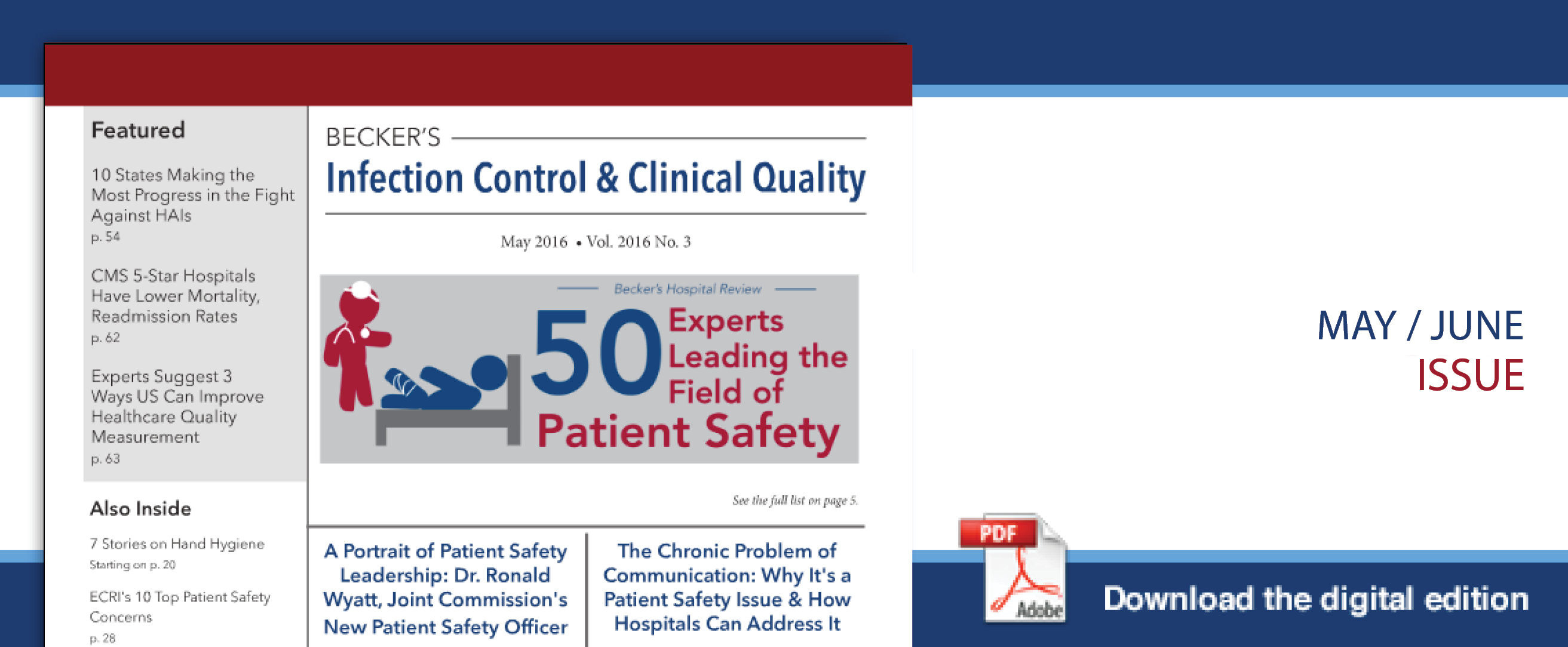May/June Issue of Becker's Infection Control and Clinical Quality
On the Cover
|
|
|
|
|
Joint Commission, NQF Announce Eisenberg Patient Safety & Quality Award Winners |
 |
A Portrait of Patient Safety Leadership: Dr. Ronald Wyatt, Joint Commission's New Patient Safety Officer |
EXECUTIVE BRIEFING
The Role of Nurses in Triple Aim
In the continuous movement toward higher levels of quality, safety and cost effectiveness, hospitals and health systems strive to meet a number of patient- and systems-related goals. Click here to continue >>
HAND HYGIENE
CDC’s 3-Step Hand-Washing Technique or WHO’s 6-Step Technique: Which is Most Effective?
Batman versus Superman. The World Health Organization’s six-step hand hygiene technique versus the CDC’s three-step method. Click here to continue >>
Is it Possible to Truly Observe Compliance to WHO’s 5 Moments of Hand Hygiene?
The effectiveness of the World Health Organization’s My 5 Moments for Hand Hygiene method is well-documented, but a study published in the American Journal of Infection Control calls into question the feasibility of observing compliance with WHO’s M5M. Click here to continue >>
Quality Improvement, Hand Hygiene Initiatives Needed in Outpatient Settings, Study Finds
More outpatient attention is needed on quality improvement initiatives for infection prevention, hand hygiene and injection safety in outpatient settings, according to a study published in the April edition of the American Journal of
Infection Control. Click here to continue >>
Hand Hygiene-Related Screen Savers May Boost Compliance: 5 Study Findings
Many hospitals post hand hygiene reminders outside patient rooms or above sinks, but a study published in the American Journal of Infection Control suggests hospitals can boost compliance by displaying hand hygiene messages on screen savers as well. Click here to continue >>
Good Hand Hygiene Key in Slowing Down Antibiotic Resistance
Poor hand-washing is among the factors contributing to the proliferation of antibiotic-resistant infections, according to a recent report issued by the Review on Antimicrobial Resistance. Click here to continue >>
Nurses Face Far More Hand Hygiene Opportunities Than Physicians, Study Finds
Does how frequently a clinician needs to wash his hands affect hand hygiene compliance rates? Click here to continue >>
Patients Transfer MDROs to Post-Acute Facilities Via Their Hands
The importance of hand hygiene compliance has been drilled into many healthcare workers, but a study released in March suggests seniors being transferred from a hospital to a post-acute care facility may require further education on the infection prevention measure. Click here to continue >>
EXECUTIVE BRIEFING
Why Every Surface Matters: The Importance of Total Room Disinfection
Infection prevention and control have been top-of-mind for hospital leaders for decades. Click here to continue >>
PATIENT SAFETY
ECRI Institute’s 10 Top Patient Safety Concerns
Patient identification problems, the mismanagement of behavioral health issues and measurement-related medication errors appear on this year’s edition of ECRI Institute’s “Top 10 Patient Safety Concerns for Healthcare Organizations.” Click here to continue >>
Researchers Say Current Hepatitis C Testing Guidelines Overlook Many Cases
Up to a quarter of all cases of hepatitis C virus infection cases may be overlooked due to overly lax federal screening guidelines, a study in Clinical Infectious Diseases suggests. Click here to continue >>
WHO Issues New Hepatitis C Infection Treatment Guidelines
In April, the World Health Organization updated its guidelines for hepatitis C infection treatment, which were originally released in 2014, because of the rapid development hepatitis C medications and treatments in the last two years. Click here to continue >>
65 Top Hospitals for Physician Communication
The following is a list of hospitals for which 92 percent or more of patients reported on their HCAHPS survey that their physician “always” communicated well. Click here to continue >>
The Chronic Problem of Communication: Why It’s a Patient Safety Issue and How Hospitals Can Address It
Effective communication at hospitals and health systems contributes to the development and sustainability of a culture of safety. Click here to continue >>
Consumer Reports Ranks Hospitals on C-Sections, Finds 60% Miss National Mark
There is incredible variation in hospital caesarean section rates — so much so that a Consumer Reports investigation finds that the single biggest variable that influences a woman’s chance of having a C-section is which hospital she chooses to deliver her baby. Click here to continue >>
Care Quality and Clinical Outcomes Vary Considerably for Colonoscopies
Research from Yale University in New Haven, Conn., revealed the quality of colonoscopies varies considerably among outpatient procedures, with many resulting in unplanned hospitalizations. Click here to continue >>
Where Are the 15 Leapfrog F hospitals?
The number of hospitals that earned a failing grade in Leapfrog’s spring Hospital Safety Scores release dropped from 34 in the fall to 15 this spring. Click here to continue >>
A Grades Up, F Grades Down in Updated Leapfrog Hospital Safety Scores: 5 Things to Know
The Leapfrog Group released its spring 2016 Hospital Safety Score update in April, assigning A through F letter grades to 2,571 hospitals in the U.S. Here are five things to know about the spring update to Leapfrog’s safety scores. Click here to continue >>
Senior Patients Frequently Prescribed Inappropriate Drugs Upon Discharge
At least one-third of older adults are given at least one potentially inappropriate prescription when they are discharged from the hospital, according to a study published in the Journal of Evaluation in Clinical Practice. Click here to continue >>
4 Factors That Empower Employees to Speak Up About Safety Culture
By interviewing 158 hospital executives, managers and staff members across six hospitals, researchers have identified four factors that encourage hospital workers to address errors and improve healthcare safety culture. Click here to continue >>
EXECUTIVE BRIEF
Reducing Healthcare Associated Infections Makes Good Sense: Medically and Financially
Healthcare-associated infections often result in tremendous emotional and financial costs for patients and their families. Click here to continue >>
SURGICAL SAFETY
These 7 Surgical Procedures Account for Most Complications, Deaths and Costs
Just seven procedures account for roughly 80 percent of all admissions, deaths, complications and costs attributable to emergency general surgery across the nation, according to a study published in JAMA Surgery. Click here to continue >>>>
NIH Program Seeks to Reduce Health Disparities in Surgical Outcomes
There is a disparity between surgical outcomes for minority and disadvantaged groups compared to the overall population. Click here to continue >>
Surgery Program Directors Say Flexible Hours for Residents Improve Education, Patient Safety
Many surgery program directors agree; residency programs with flexible policies for duty hour requirements are superior to standard requirements regarding resident education and well-being, as well as patient care, according to a study in Journal of the American College of Surgeons. Click here to continue >>
AORN Campaign Aims to ‘Clear’ Hazardous Smoke From ORs
Surgical smoke, or plume, is sometimes produced in operating rooms as a byproduct of medical devices. Click here to continue >>
Study Finds Surgeon Skill Doesn’t Affect Long-Term Outcomes of Bariatric Surgery
Although surgical skill affects patients’ risks for early complications, it does not affect postoperative weight loss or resolution of medical conditions one year following laparoscopic gastric bypass, according to a study published
in JAMA Surgery. Click here to continue >>
Hypothermia During Surgery Associated With Greater Infection Risk
Hypothermia commonly occurs during surgery and is associated with increased infection risk, according to research from Detroit-based Henry Ford Health System. Click here to continue >>
Patients Undergoing Bladder Cancer Surgery are at Major Risk for Blood Clots, Study Finds
After undergoing a radical cystectomy, bladder cancer patients should receive venous thromboembolism prophylaxis treatment well beyond their hospital discharge, according to a new study in BJU International. Click here to continue >>
Feds Seek Information on Concurrent Surgeries at 20 Medical Facilities: 6 Things to Know
Twenty hospitals and health systems in the United States were asked to describe their policies for concurrent surgeries, when a surgeon runs two operations at the same time, according to a Pittsburgh Post-Gazette report. Click here to continue >>
New Guidelines Say Surgeons Should Inform Patients of Concurrent Procedures
The American College of Surgeons issued new standards April 13 for surgeons performing procedures simultaneously. Click here to continue >>
INFECTION PREVENTION & ANTIBIOTIC RESISTANCE
2 New Jersey Hospitals Unite Against C. diff
The Valley Hospital in Ridgewood, N.J., and Holy Name Medical Center in Teaneck, N.J., are uniting in the fight against drug-resistant healthcare-acquired Clostridium difficile infections. Click here to continue >>
10 States Making the Most Progress in the Fight Against HAIs
The CDC published its annual National and State Healthcare-Associated Infections Progress Report, which shows hospitals across the national are getting better at fighting HAIs. Click here to continue >>
UTI Intervention Remains Successful for 8 Years, Study Finds
Urinary tract infections are the most common type of healthcare-associated infection in the U.S. For hospitals looking to combat UTIs, a study published in March in the American Journal of Infection Control highlights an intervention
that was successful for nearly a decade. Click here to continue >>
5 Highlights From the CDC’s Annual HAI Progress Report
Results of the CDC’s National and State Healthcare-Associated Infections Progress Report show hospitals are getting better at fighting HAIs, particularly drug-resistant superbugs. Click here to continue >>
C. diff Transmission in Hospitalized Patients, Asymptomatic Carriers and Community Sources
Even though Clostridium difficile infections affect more than 250,000 hospital patients each year, relatively little is known about how the bacterium spreads. Click here to continue >>
Research Reveals C. diff is More Common in Community Than Previously Realized
Frequently, when people hear about Clostridium difficile, they think of hospitals or other healthcare settings. Click here to continue >>
Central Line Care Maintenance Bundle Improves Catheter Dressing Care, Study Finds
Changing the dressing on a patient’s catheter is a crucial infection prevention method that can be improved by implementing a multifaceted catheter care maintenance bundle, according to a recent study published in March the
journal Infection Control & Hospital Epidemiology. Click here to continue >>
MRSA Antibiotic Susceptibility Changing in Pediatric Patients, Study Finds
The proportion of Staphylococcus aureus infections in children due to methicillin-resistant strains has decreased, according to a study in Pediatrics and covered by HealthDay. Click here to continue >>
Research Says Skin Tests to Predict Allergies to Antibiotics are Ineffective
A new study from the Research Institute of the McGill University Health Centre in Montreal has found skin tests used to predict allergies to amoxicillin are ineffective. Click here to continue >>
EXECUTIVE BRIEFING
Refining Data Capture Techniques to Enhance Efficiency, Patient Safety
Healthcare organizations face a suite of evolving threats, many of which are invisible. From the shadowy movements of cybercriminals who grow increasingly better at being everywhere and nowhere at the same time, to the microscopic and deadly bugs that haunt the most unsuspecting surfaces and grow more resistant to drug eradication each year, the “bad guys” are hard to pin down. Click here to continue >>
PATIENT SATISFACTION & QUALITY MEASUREMENT
CMS 5-Star Hospitals Have Lower Mortality and Readmission Rates, Study Finds
Even though CMS’ star ratings system for hospitals is based solely on patient experience scores, researchers from Harvard have found that higher rated hospitals do in fact have lower mortality and readmission rates than their lower
rated counterparts. Click here to continue >>
Study Suggests Yelp can Supplement the Federal Government’s Survey of Patients’ Hospital Experiences
Yelp reviews of hospitals cover topics not found in more traditional patient experience surveys, according to the results of a study published in the April issue of Health Affairs. Click here to continue >>
CMS Delays Overall Hospital Star Ratings Release: 4 Things to Know
On April 20, just one day before its scheduled public launch, CMS postponed the release of its overall hospital star ratings program to July, the agency said in a statement. Click here to continue >>
Experts Suggest 3 Ways the US Can Improve Healthcare Quality Measurement
While the U.S. healthcare industry has made strides toward eliminating adverse events, many problems still remain. Click here to continue >>
The Evolution of the CXO: 5 Findings
Chief experience officers, or other similarly titled leaders, are one of the newest members of the hospital and health system C-suite, tasked with managing and improving patients’ experience within the healthcare system. Click here to continue >>
10 Hospitals Getting the Most Positive Buzz on Twitter
Tweets can be a valuable source of insight into what patients truly think about the hospitals they visit, and some hospitals — particularly children’s hospitals — get the bulk of positive buzz on Twitter, according to analysis from
CrowdClinical.com. Click here to continue >>
EXECUTIVE BRIEFING
The Persistence of CIED Infections: A Progress Report on Improving Outcomes and Lowering Costs
The past several years have seen a significant decrease in healthcare-associated infections, in particular central line-associated bloodstream infections and certain surgical site infections. Click here to continue >>
Click here to view the featured stories and download a pdf of the issue.




